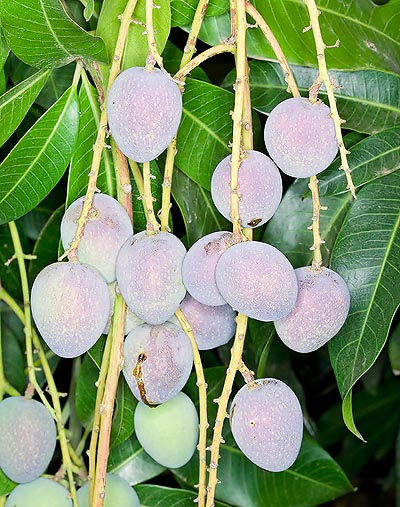Family : Anacardiaceae

Text © Pietro Puccio

English translation by Mario Beltramini

Edible fruits and rootstock for common mango © Giuseppe Mazza
The name of the genus comes from the combination of one of the local names of the fruit, “manga” and from the Latin verb “fero” = I carry.
The name of the species comes from its local name “kasturi”.
Common names: “buah kasturi” (Indonesian); “Kalimantan mango” (English).
The plant is an evergreen tree which can reach the height of about 25 m and a diameter exceeding the metre in the old specimens, with very similar characteristics to those of the Mangifera indica, which please see; the most important difference stands in the fruits which are ovoid, slightly compressed, long about 6 cm, weighing 50 to 80 grams, of dark purple colour, almost completely black when ripen. The pulp is fibrous, of orange colour and with a very pleasant perfume and taste.
The fruits, much appreciated by natives in spite of their high cost and the supply shortage, are consumed mostly when fresh, but some very good jams can be made with them. The fructification is abundant, but variable.
It usually reproduces by seed, which must be fresh for getting a high germination, to be kept in water at 20-25° C for some hours and then placed to root in a sandy substratum at the same temperature. The germination takes place in 10 to 20 days.
In spite of the good organoleptic characteristics of the fruit and of its resistance to wet habitats and to fungal diseases, such as the anthracnose, and for said reasons is potentially a very good rootstock for the common mango (Mangifera indica), the plant is little cultivated outside from a restricted area close to the city of Banjarmasin, in southern Borneo, of which is the floral emblem, due to its slow growth, as it takes many years before reaching the production starting from the seed, and due to the small shape of the fruits.
→ To appreciate the biodiversity within the ANACARDIACEAE family please click here.
